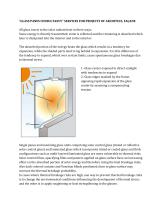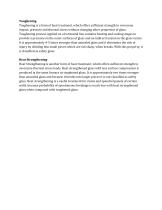 Website:
Şişecam
Website:
Şişecam
Catalog excerpts

“GLASS PANES CONSULTANCY” SERVICES FOR PROJECTS OF ARCHITECS, FAÇADE All glass reacts to the solar radiant heat in three ways. Some energy is directly transmitted; some is reflected and the remaining is absorbed which later is dissipated into the interior and to the exterior. The absorbed portion of the energy heats the glass which results in a tendency for expansion, while the shaded parts tend to lag behind in expansion. It is this difference of the tendency to expand, which over certain limits, cause spontaneous glass breakages due to thermal stress. 1- Glass center exposed to direct sunlight with tendencies to expand 2- Glass edges masked by the frame, opposing rapid expansion of the glass center by assuming a compensating tension Single panes and insulating glass units comprising solar control glass (tinted or reflective solar control glass) and laminated glass which incorporate tinted or coated glass and thick configurations such as multi-layered laminated glass are more vulnerable to thermal risks. Solar control films, opacifying films and posters applied on glass surface have an increasing effect on the absorbed portion of solar energy and therefore rising thermal breakage risks. Also dark colored curtains and Venetian blinds positioned close to glass surface may increase the thermal breakage probability. In cases where thermal breakage risks are high, one way to prevent thermal breakage risks is to change the environmental conditions influencing the development of thermal stress; and the other is to apply toughening or heat strengthening to the glasse
Open the catalog to page 1
Toughening Toughening is a form of heat treatment, which offers sufficient strength to overcome impact, pressure and thermal stress without changing other properties of glass. Toughening process applied on a horizontal line contains heating and cooling stages to provide a pressure on the outer surfaces of glass and an indirect tension to the glass center. It is approximately 4-5 times stronger than annealed glass and it eliminates the risk of injury by dividing into small pieces which are not sharp, when breaks. With this property, it is classified as safety glass. Heat Strengthening Heat...
Open the catalog to page 2All Şişecam catalogs and technical brochures
-
Solar Glass
2 Pages
-
Lacquered Glass
5 Pages
-
Coated Glass
13 Pages
-
Şişecam Tentesol Titanium
13 Pages
-
Şişecam Tentesol
13 Pages
-
Şişecam Temperable Low-E Glass
13 Pages
-
Reference Projects 2021
107 Pages
-
FLOTAL
2 Pages
-
Şişecam Low-E Glass
24 Pages
-
Şişecam Wired Glass
2 Pages
-
Şişecam Tinted Float Glass
4 Pages
-
Şişecam Picture Frame Glass
2 Pages
-
Şişecam Patterned Glass
2 Pages
-
Şişecam Laminated Glass
2 Pages
-
Şişecam Lacquered Glass
2 Pages

























